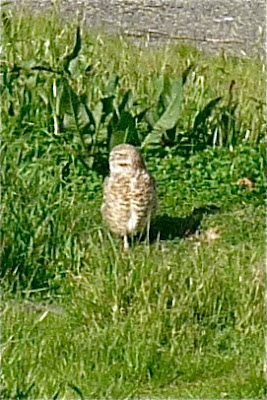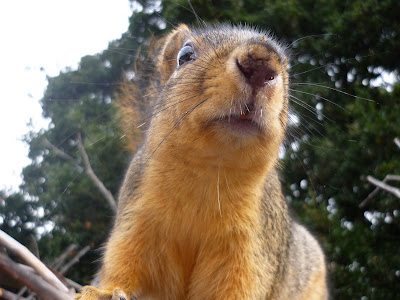Inspired by some equipment I saw at the Flyway Festival, I decided to make my own camera-to-binoculars gasket. One toilet tube and a roll of handlebar tape later...

I had something which was marginally easier to use than just pressing the camera up to the lens.

I went to Arrowhead Marsh to test it out.

First victim: Cross-process turkey vulture eating some roadkill:

Starlings:

This trip got me thinking about the old "habitat specialization" thing. Shorebirds are the classic example of supposedly splitting up resources according to behavior and even body shape. Shovelers have big ol' beaks for filtering plankton:

And a nearby green-winged teal does its thing.

The avocets also seemed to like the "surrounded by grass" water more than the "mudflat" water. You can see from this pic that their heads are turning red for breeding...

Jackrabbit also likes the tall grass.

Also in the grass-water environment, a greater yellowlegs held itself aloof from the duck-avocet-gull party. It's probably working on its novel, feeling deep feelings that others just don't 'get'.

Meanwhile, on the other side of the road, kildeer picked up tiny things from on top of the algae-covered rocks:

Suddenly we saw the kildeer take off, followed by a big flock of avocets, and then the starlings. Who did that?

Me. It was me. Hawk. I'm actually not sure what kind of hawk this is. It's one of those difficult "brown, probably young" IDs.... it was making the red-shouldered hawk sound, keyerr-keyerrr, and I sort of saw that pale half-moon on the wing. It doesn't have the red tail's tum-band, but then, it doesn't have a stripy tail, either. The dark head and non-streaky sides might mean a harrier... Well, chalk another one up to "keep practicin' the raptors."
A bit later though, we DID see a red tail, which we saw lift into the air, burdened down by something heavy and squirming. But then ol' buttertalons dropped it and flew into a tree further away. Turns out the snack was a ground squirrel. An ex-ground squirrel.

What's up, redtail? You put it on your plate, now you have to eat it! What's wrong, you don't like eating near children playing badminton? Yeah, me neither.

But back to the habitat split up thing. Away from the rocks and grass-water zones, there's the tall grass-mud-salt water land, favorite of the willet and marbled godwit. I saw the godwits really shoving their faces down in the mud and they definitely had a few more inches of face than the willet. They were picking up what looked like jellybeans and chomping them down. Tiny clams maybe? Do they eat the shells too? Hmmm...

A lucky spotting this time, a clapper rail! Its
distinctive call gave it away right before it scurried across the channel as the tide went out. Right back into the tall grass.

Last time I saw a clapper rail here, it had a radio antenna sticking out of its back. The CA subspecies of this rail is endangered, so they're prime candidates for being tracked for conservation. It's impressive that they are able to survive here, so close to the airport and freeway. Maybe the antenna helped them blend into the long grass too...
On the bridge overlooking the deeper water, there was a surf scoter, or, as I like to think of it, a crazy-eyed clown face duck. Love these things:

Anyway, these photos are obviously still not professional grade or anything, but if you look back at the first photo of the marsh at those tiny white dots, that shows you how far away most of these birds actually were... I think the toilet-tube has done a pretty good job.
 Alcatraz isn't really known for having birds on it. It's more of a history and architecture thing.
Alcatraz isn't really known for having birds on it. It's more of a history and architecture thing. Architecture with some jungle let into it.
Architecture with some jungle let into it. You probably wouldn't be that surprised to see a gull on it...
You probably wouldn't be that surprised to see a gull on it...
 It's true, Alcatraz is actually an important breeding site for Western gulls, as well as Brant's cormorant and Pigeon Guillemots (which nest in abandoned pipes!). I only spotted gulls, but it might be worthwhile to come back in the summer and try to see baby gulls...
It's true, Alcatraz is actually an important breeding site for Western gulls, as well as Brant's cormorant and Pigeon Guillemots (which nest in abandoned pipes!). I only spotted gulls, but it might be worthwhile to come back in the summer and try to see baby gulls... In case you are thinking the above picture looks like just some boring blackbird, compare it to this picture of an actual boring blackbird from the same tree.
In case you are thinking the above picture looks like just some boring blackbird, compare it to this picture of an actual boring blackbird from the same tree. See? ACTION GRACKLE with Long Tail accessories.
See? ACTION GRACKLE with Long Tail accessories.





































